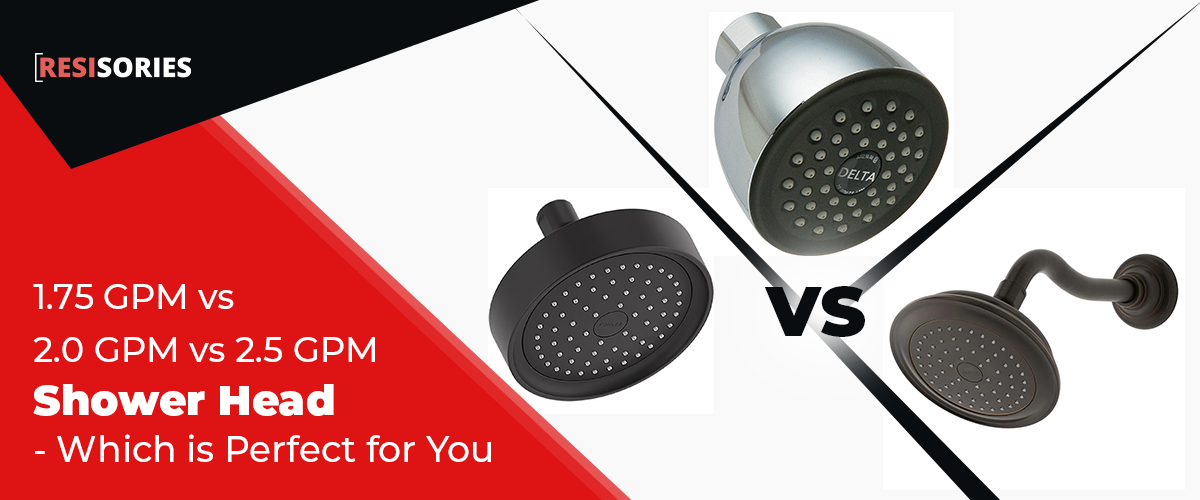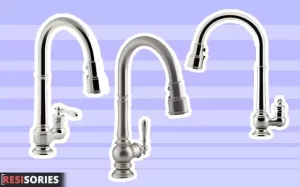Is your shower time enjoyable or do you just roll your eyes at how the water takes long to hit your skin? The flow rate of water is determined by the GPM of the shower head fitted in your bathroom. Take note that the water pressure from your shower head is directly proportional to the GPM. So, having a 1.75 GPM over a 2.5 GPM means less water pressure.
For less confusion, the three shower heads in comparison will be likened to a ceiling fan with control one, two, and three. Did I hear you ask, “which is better?”
With each of the shower heads having their pros and cons, it all comes down to your personal preference, bathroom type, water pressure around the house, and comfortability, after weighing your options.
Key Takeaways
Is There Any Difference Between 1.75, 2.0, 2.5 GPM Shower heads?
There is no notable similarity among the shower heads as their flow rates cannot be, in any way, likened.
So let’s have a look to each one.

The 1.75 GPM
1.75 GPM shower head has a very specific purpose. The water pressure is set to the perfect level for people who suffer from low-pressure sensitivity – or it’s just set to a lower setting because you prefer a lighter, less intense shower experience. The 1.75GPM shower heads are designed to reduce water consumption by up to 75% of what you normally use per minute.
Pros and Cons of 1.75 GPM shower head
Advantages
Disadvantages
Is 1.75 GPM enough for a shower?
Yes, 1.75 GPM is enough for a shower, especially is you have skin sensibility.
Low flow shower heads can save water usage by 39.86% to 47.52%. So it’s an environmentally friendly device. It makes your home eco-friendly. At the same time, it can help you minimize the monthly water bill cost.
Advantages of the low pressure shower head
Disadvantage of the low pressure shower head
The 1.75 GPM reduces cost since lesser gallons of water is used in minutes. If lesser gallons of water is used, then more water is saved. While the advantages of the 1.75 GPM are encouraging, the disadvantage isn’t.
Are there lower than 1.75 GPM shower heads?
Yes, there are shower heads that have a flow rate lower than 1.75 GPM, such as water-saving shower heads that can have a flow rate of 1.5 GPM or even lower like 1 GPM shower head (see examples below).
It is important to note that while low GPM shower heads may take some time to getting used to, they can be an effective way to reduce your water usage and lower your monthly utility bills. Additionally, many water-saving shower heads are designed with eco-friendly materials and feature sleek, modern designs that can enhance the look of your bathroom.
2.0 GPM Shower head
In the wake of a drought, people are trying to find ways to use less water in their daily lives. One of the most important things you can do is to have a low-flow shower head. Shower heads with 2 GPM or less allow families and across the nation to save up to 75% on water by not having showers that last for an hour[2].
A decrease in water use, for instance, can lead to savings on water bills and a smaller footprint on the planet. The maximum allowed flow rate is 2 GPM in some locations. When water is scarce, as it often is in motor homes or when using a well, the lower flow rate is also beneficial. The “Eco Performance” (EP) shower heads have even lower flow rates than the standard shower heads.
Pros and Cons of 2.0 GPM shower head
Advantages
Disadvantages
2.5 GPM Shower Head
A 2.5 GPM shower head can significantly improve the quality of your shower by increasing the water pressure.
Greater water pressure makes it simpler to remove soap residue. The soothing effect of the high-pressure water is also beneficial to the skin. However, it’s not without its negatives. The excess water you consume, for example, can have a significant effect on both your water bill and the natural world. Remember that in some areas, a shower head with a flow rate of more than 2.5 gallons per minute (GPM) is prohibited by law.
Pros and Cons of 2.5 GPM shower head
Advantages
Disadvantages
Which Shower Head Flow Rate Needed For A Good Shower?
Since 1994[3], producers of shower heads have been subject to federal rules capping the flow rate at 2.5 gallons per minute (GPM). The state of California has passed, in July 2018[4], its own legislation reducing the allowed flow rate from 2.0 to 1.8 gallons per minute (GPM). Regulations on water flow help conserve billions of gallons of water yearly, and cutting-edge technology can keep your shower as good as new. You shouldn’t have to put up with a crappy shower just because of rules (even if they tend to change with each presidents[5]).
FAQs
Is It Better To Have A Higher GPM For The Shower Head?
When compared to standard shower heads, high-pressure models consume roughly 20% less water. They save money on heating costs as well as water costs due to reduced water use.
Are Low Flow Shower Heads Worth It?
Water usage can be cut by as much as 40 percent when using a low-flow shower head. In addition to helping the environment, lowering your water cost every month will add up to a large annual savings. Heating water for showers requires electricity, so conserving water has a double benefit.
What is GPM meaning ?
GPM stands for “gallons per minute” and it’s a measurement used to determine the amount of water that flows out of a shower head in one minute.
Final Verdict
Shower head Type
What We Like
What We Don’t Like
In conclusion, if you are conscious of the environment or want to reduce your water bill monthly, we recommend using the 1.75 GPM or 1.80 GPM shower head. If you want to relax while showering, choose a massage shower head with a flow rate of 2.0 GPM. We do not suggest the 2.5 GPM shower heads, though removing your pain points makes the shower more relaxing.
You also may like:
How To Clean A Rain Shower Head
Is Delta HydroRain Shower heads Worth It?
How To Clean Shower head With Vinegar
1/4 Vs 3/8 Vs 1/2 Frameless Shower Doors Glass
Find Best Shower Doors For Small Bathrooms
References:
[1] https://www.epa.gov/watersense/showerheads
[2] https://home-water-works.org/indoor-use/showers
[3] https://www.deltafaucet.com/il/home-improvement-101/understanding-shower-flow-rates
[4] https://www.latimes.com/local/lanow/la-me-ln-shower-heads-20150812-story.html
[5] https://www.washingtonpost.com/climate-environment/2021/12/15/trump-showerheads-efficiency-biden-climate/







